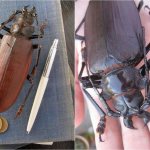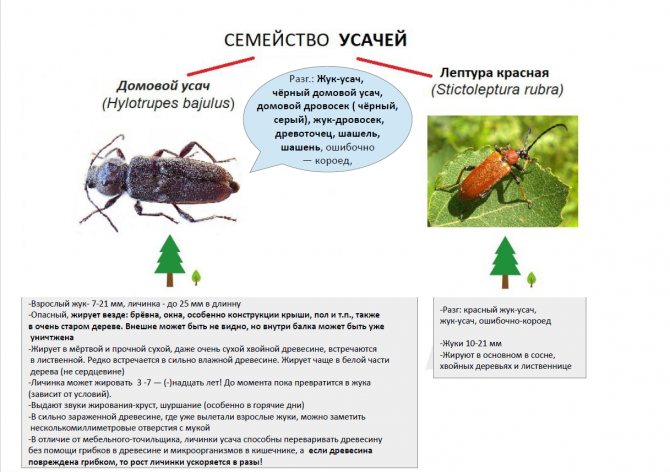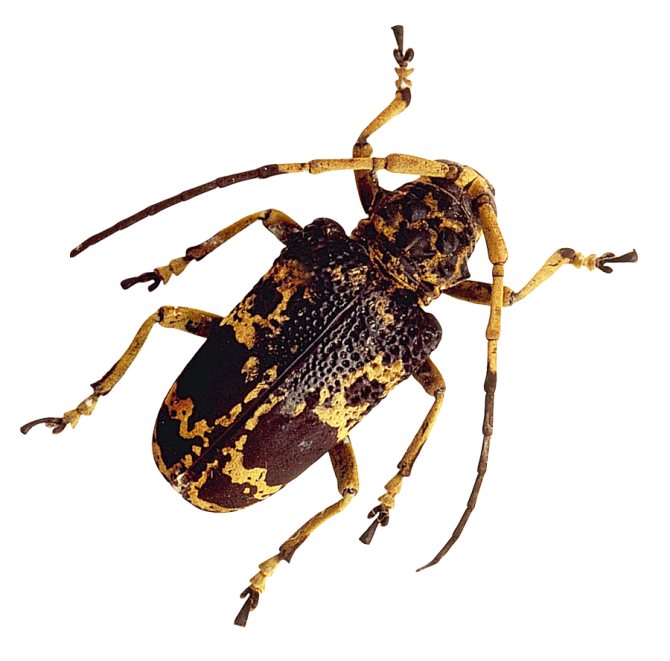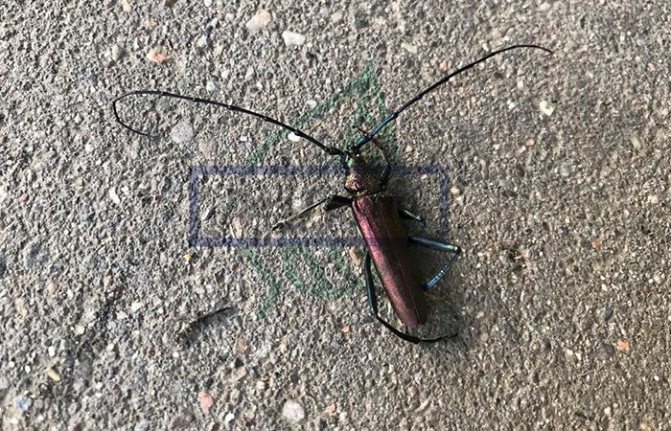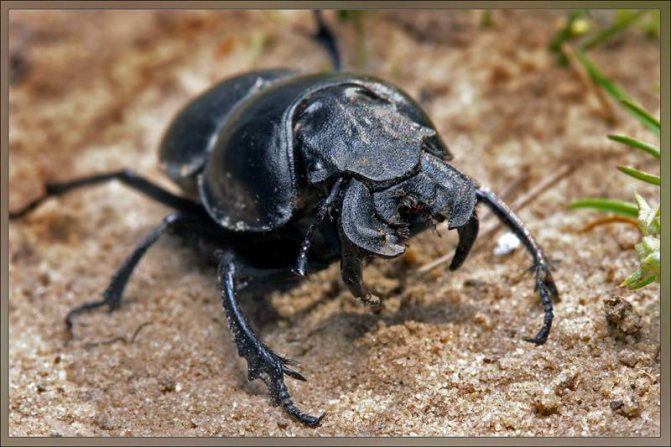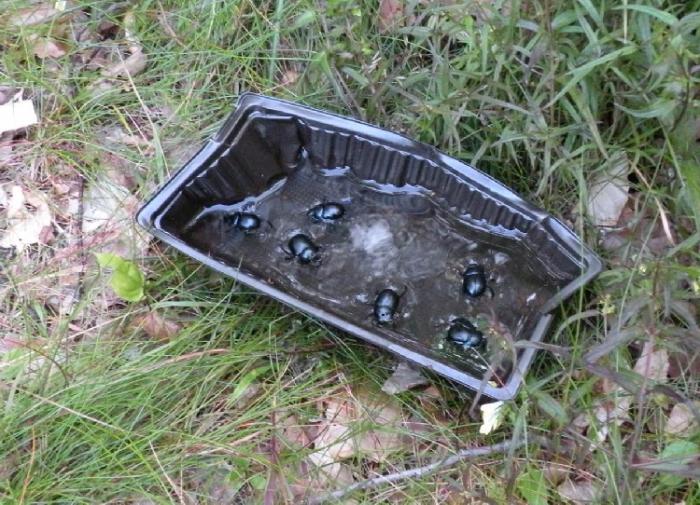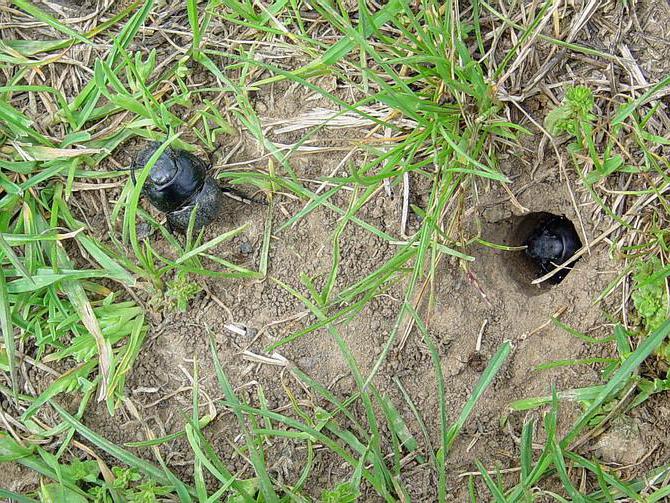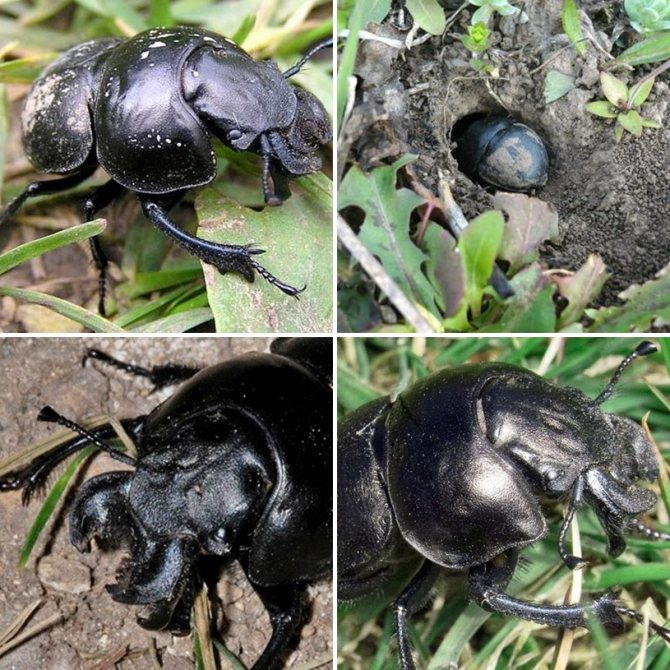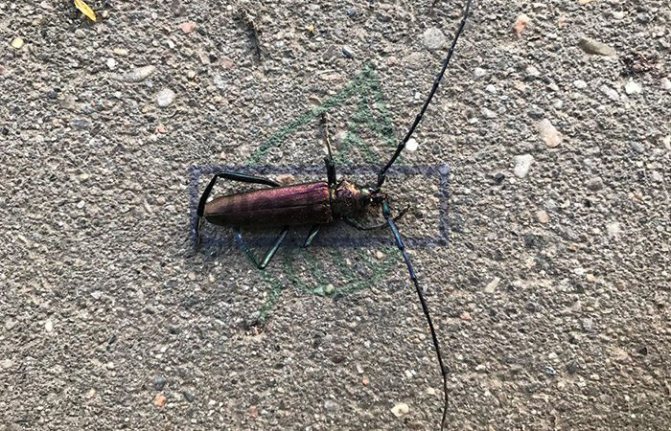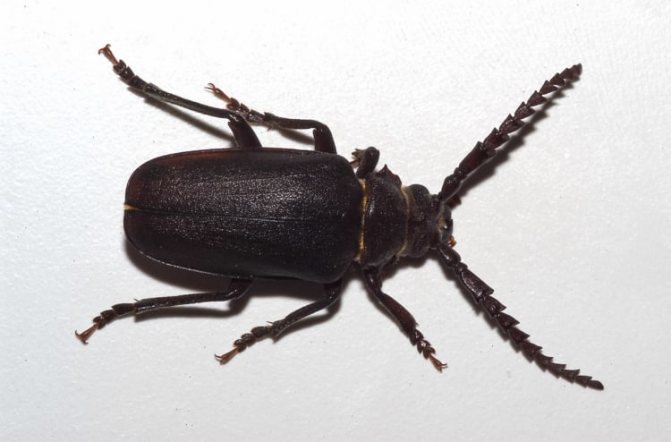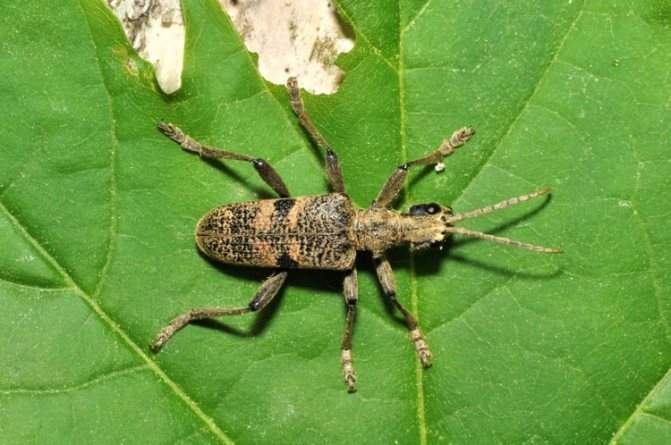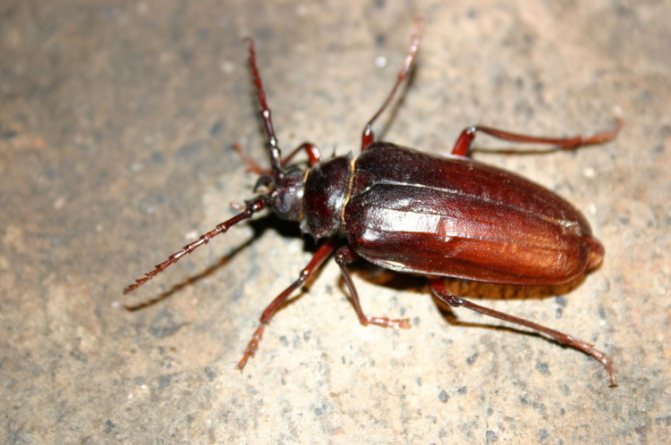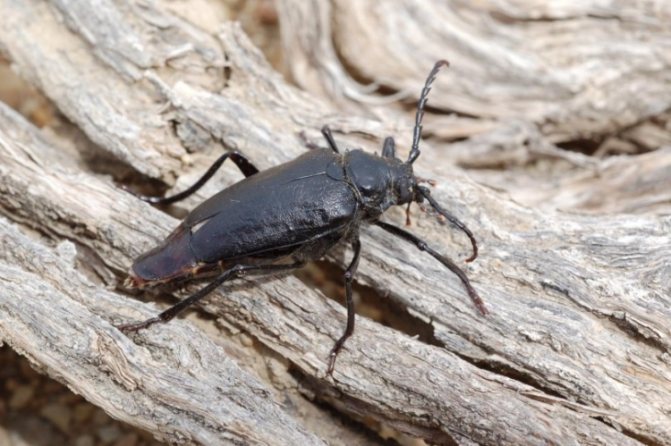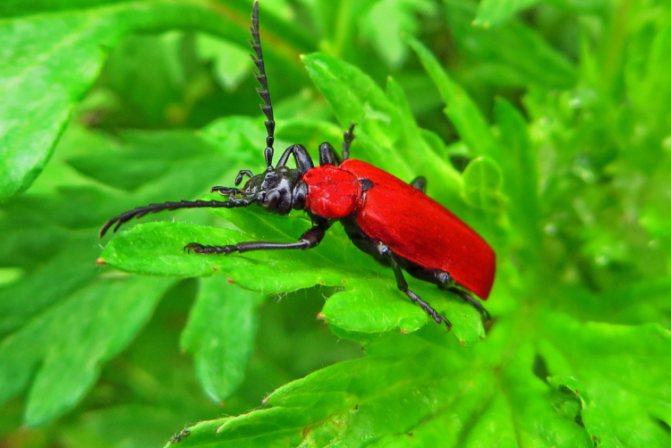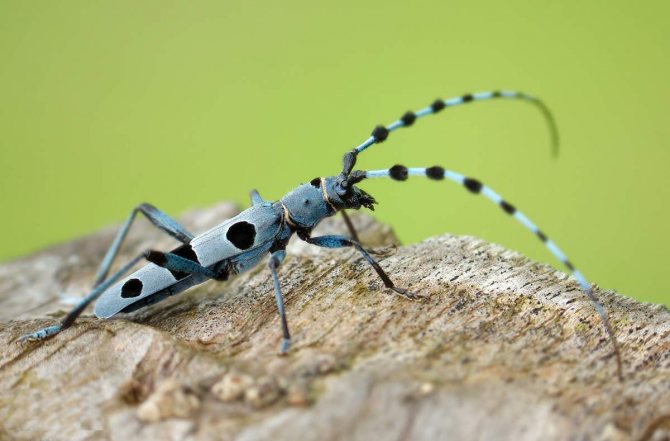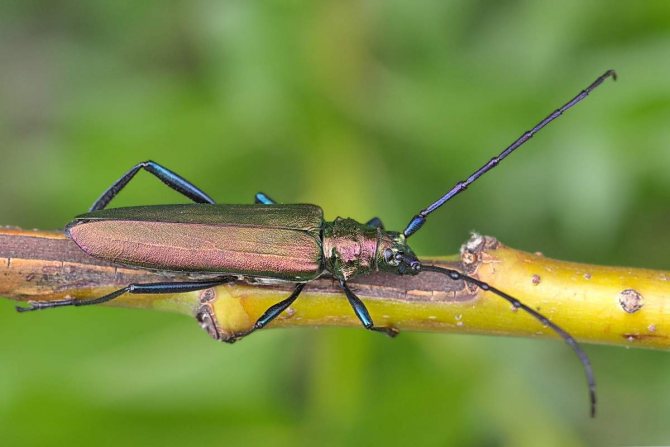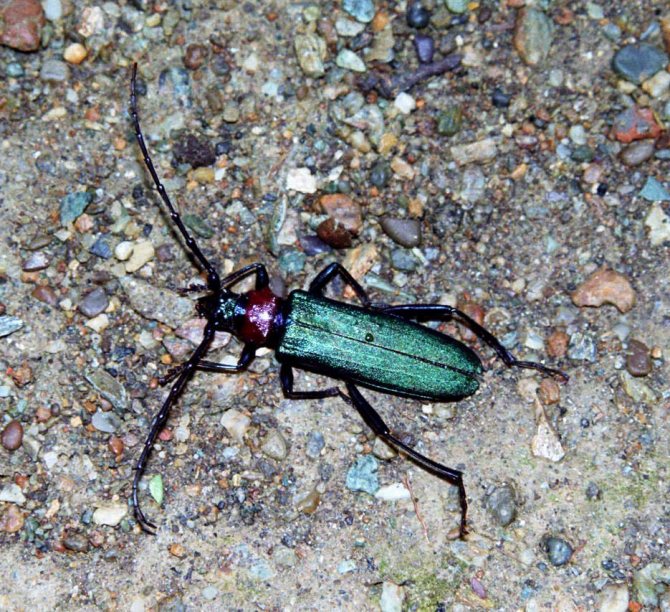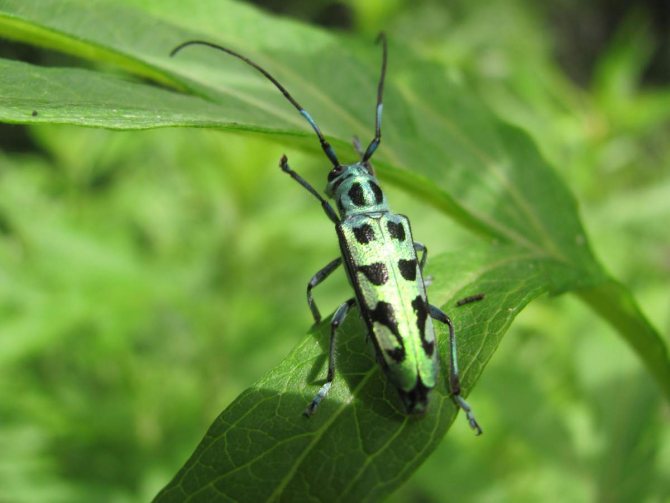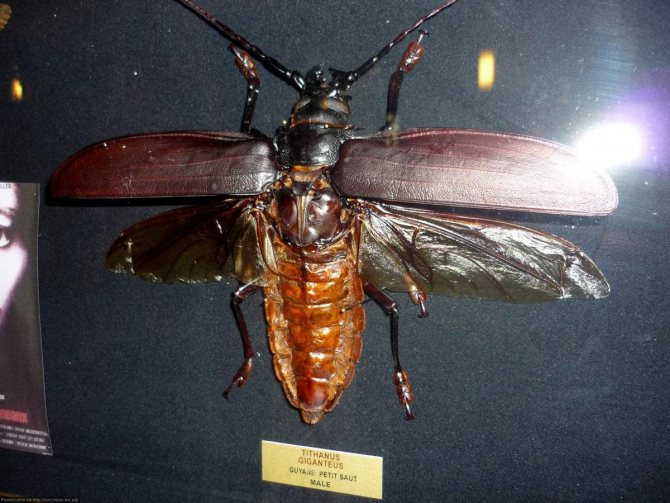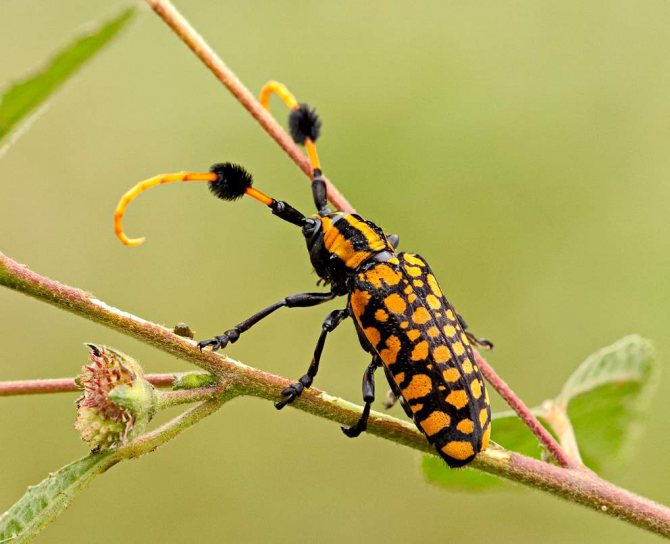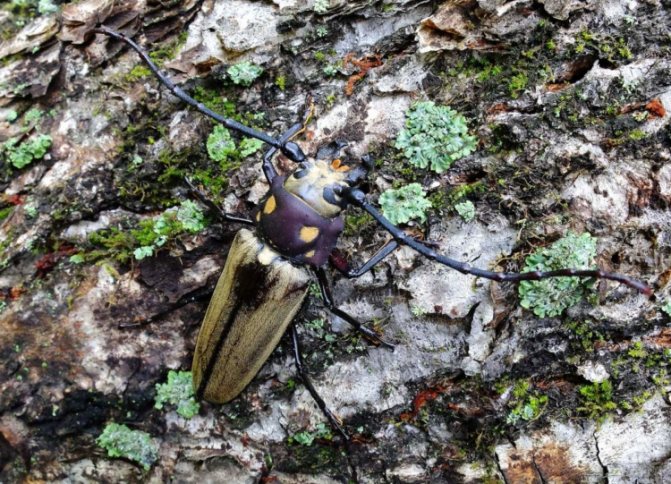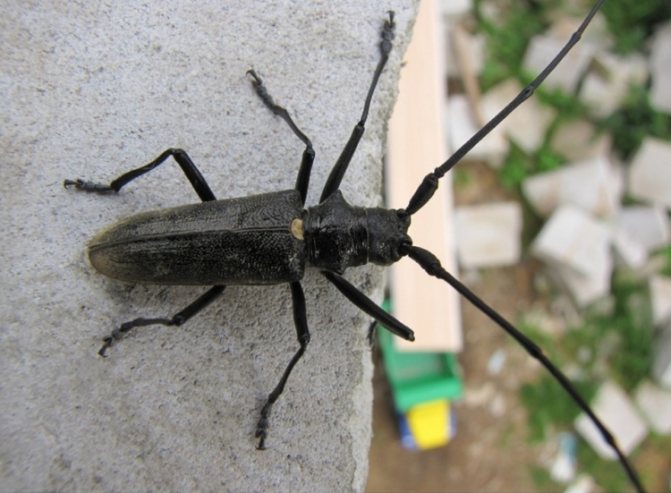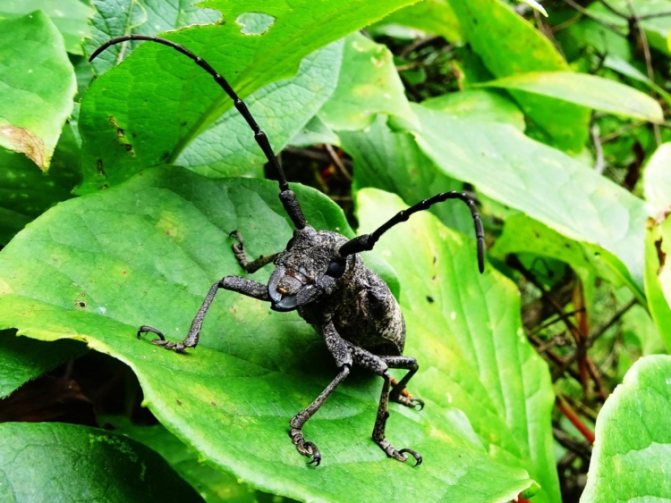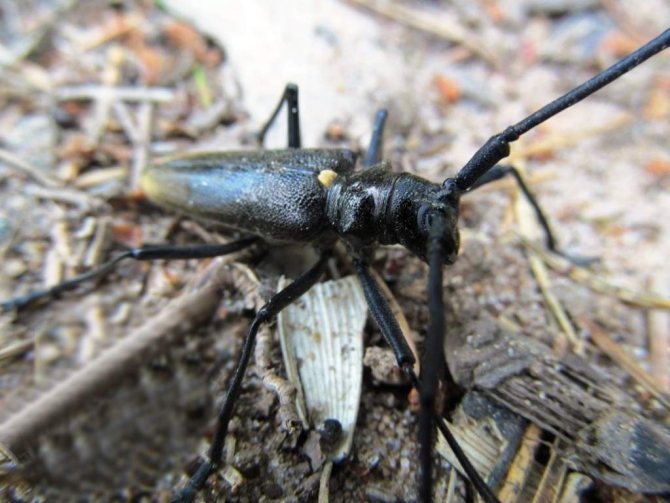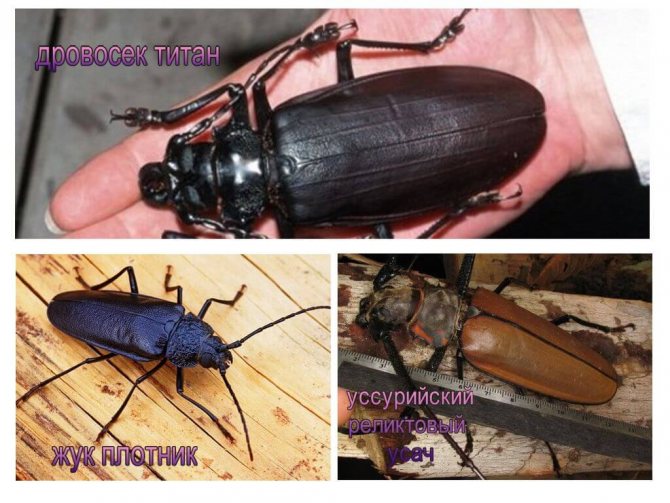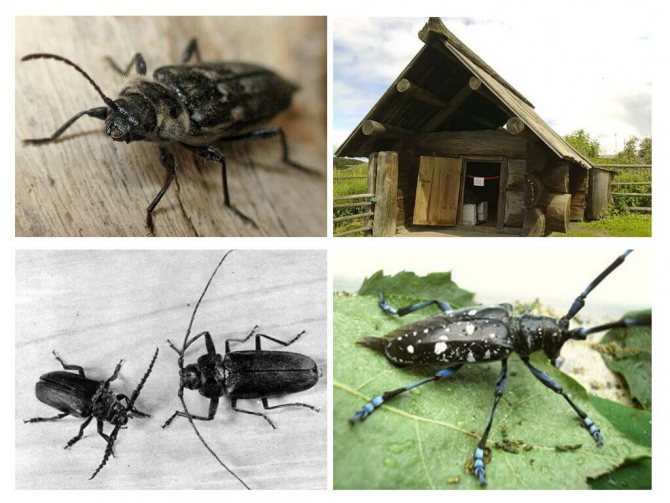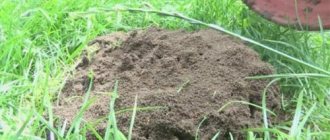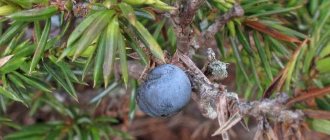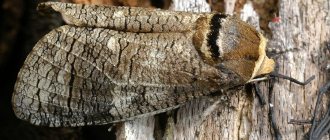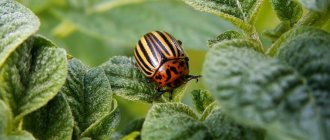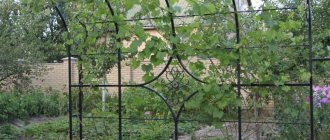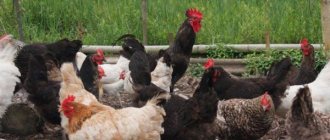Lumberjack beetles are also called barbel beetles. This is a large family of beetles. One of the main features of these beetles, as well as their distinctive feature, is their segmented long whiskers. The whiskers can be longer than the body itself, sometimes 2-5 times.
The total number, according to an approximate estimate, is about 26 thousand species, but this figure is not accurate, since new species are discovered every year. Lumberjacks are numerous throughout the world.
For the most part, these beetles are of medium size, but there are also giants, which are the largest beetles on earth. One of the largest members of the family is the titan lumberjack living in South America. Its body length reaches 167 millimeters. Another huge beetle, the large-toothed deer-horned beetle, also lives in South America, reaches a length of 169 millimeters. The largest European beetle is the carpenter barbel, which grows up to 6 centimeters in length. And the largest barbel beetle in Russia - the Ussuri relic barbel reaches 11 centimeters.
Many lumberjack beetles are capable of making powerful squeaking sounds, which they reproduce by rubbing the ribs on the prothorax against the ribbed surface of the mesothorax. Some species, such as the Hawaiian woodcutters, reproduce sounds by rubbing the hips of their hind legs against the elytra. Beetles make these sounds during danger to scare off the enemy.
An incredibly huge giant lumberjack from the family of barbel (Cerambycidae).
Woodcutter beetles are very diverse in size, shape, color, presence of outgrowths and thorns.
Strigun beetle - How to behave with harmful beetles? Tips for their destruction at the site + Video
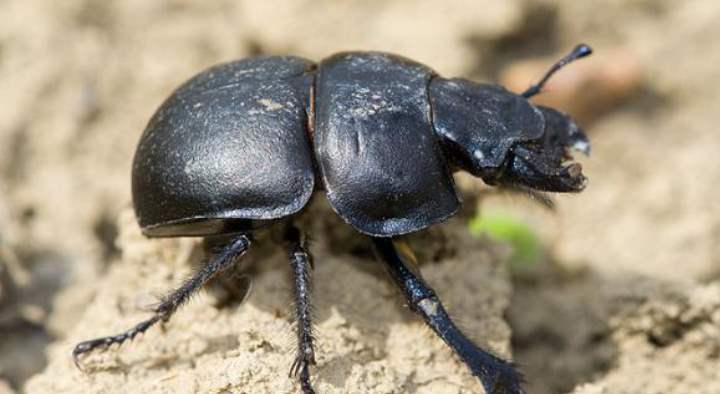
The strigun beetle is a dangerous insect in the summer cottage. With the development of agriculture, this type of beetle began to prevail. About what dangerous beetles are, and what they eat - we will tell you in detail in our article.
The snowflake's appearance is very unattractive. In length, the insect does not exceed 2-3 cm. The head, in relation to the body, is very large and twice as large. Massive jaws begin to move actively when you take the beetle in your hands.
Sometimes this insect is confused with the May beetle. But the two are completely different. The strigun beetle does not fly and appears on garden plots already in mid-April.
Lifestyle and habitat
Barbel beetle inhabits all over the planet where there are forests. Their distribution depends on the availability of food - mainly trees. The exceptions are the Arctic and Antarctic, precisely because of the lack of a food base.
By way of life, they are quite mobile. They crawl, many very quickly. Some of them can fly. If you pick up a beetle, it emits a characteristic chirp. Their way of life depends on the climate and habitat.
In the southern regions, these insects "take their wings" from the middle of spring. Central Asian beetles begin to fly closer to autumn. Some are active during the day; they feed mainly on flowers that unfold during the day. Others are active at night. Their food does not hide in the dark.
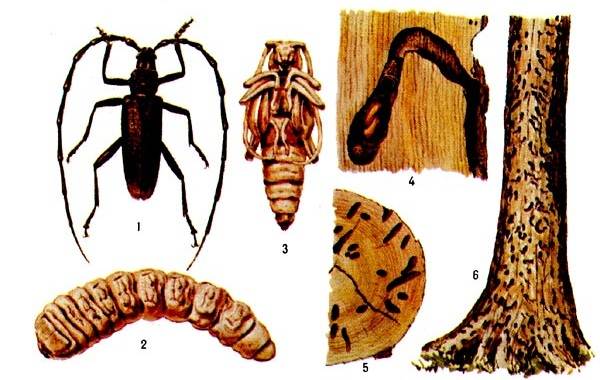

Both nocturnal and daytime beetles find hard-to-reach places for resting or mating. The flight range is also determined depending on the size. The larger the beetle, the less it flies, the more it crawls. They lead a very secretive lifestyle.Seeing an adult beetle in the forest is a real gift for an entomologist and a wake-up call for a forester.
Characteristics and description of the black beetle
Mostly large beetles are nocturnal, but they can also be found during the day. Snowflakes live in burrows, which are located in fields, steep slopes and ravines. Snowflake beetle larvae are also found underground. They appear on the surface only after they are fully ripe.
Strigun beetle, what is dangerous for humans
This beetle is popularly called virgin land and kravchik. Appearing at a summer cottage, this parasite destroys all plantings. Strigun is an insidious insect. And in almost a couple of days, he is able to eat all young plantings, seedlings and even small shrubs.
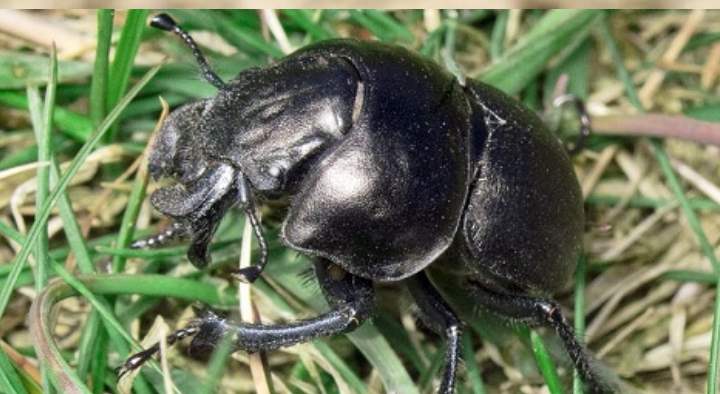

As for humans, this type of insect is safe. He does not attack people and, moreover, does not cut his hair, as many believe. Few people know that beetles do not attack first, aggression is justified by a defensive reaction to external factors.
ATTENTION! Only 4 beetles will be able to clear the garden area of 10 m2 from greenery.
If you do not take the necessary measures in time, you can lose most of the crop. The situation is further complicated by the fact that it is practically impossible to detect the beetle before its active influence.
Strigun beetle development cycle
Insects of this species can nibble on stems twice as thick as themselves. They can also climb over a meter and eat leaves and young shoots. The strigun beetle forms the broken greens into small cubes, moistening them with its saliva. Thus, preventing the processes of decay. He drags the resulting silage lumps into the burrow for posterity.
The female snowflake beetle lays up to 20 eggs per season. The larva will hatch two weeks after the start of clutch. They are white in color and up to 40 mm long. The larva also has a pronounced head. As it grows, the larva begins to molt, about 3 times until full maturation. Feeding on the stocks brought by adults, the larva turns into a pupa. After 2-3 weeks, a full-fledged beetle will hatch from it.
Due to the fact that the strigun beetle insect spends a large amount of time underground, it is difficult to detect and exterminate it, but there are ways to combat it.
Strigun beetle - lifespan
Snowy beetles are not only afraid of summer residents. Their larvae are hunted by flies, kozheedy and toddlers. And the beetles themselves hide from ticks, rooks and jackdaws.
The lifespan of a snowflake does not allow him to live permanently in a hole. On the contrary, in a short period of time, the female must lay eggs, provide the young with nutritious greens and protect their larvae. In addition, several families of these harmful insects can be located in one area at once. And they all actively interact with each other.
Fighting the shearling is a difficult task. First of all, because the beetle does not fly, but sits deep in the hole. Therefore, chemicals are not very helpful in pest control. But summer residents have found several ways to destroy beetles, but we will talk about this below.
Control methods
Methods of dealing with the snow beetle require almost a creative approach, since the species is especially tenacious and prolific. Again, the tunnels of his burrows provide a safe hideout.
Do chemicals help?
Insecticides for the destruction of insects are mostly powerless, hiding in a hole, the pest will calmly sit out the processing time, and then take up its own. It is possible to treat the soil with chemicals during reproduction, according to the observations of farmers, this is the period of flowering of apple trees.
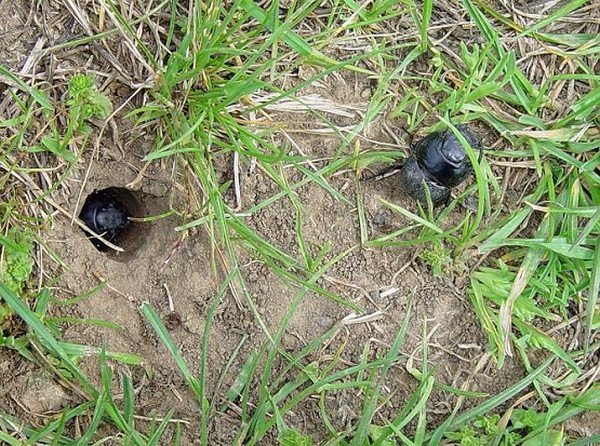

Preparations can be used to treat the soil and the entrances to burrows, in the hope that this will somehow restrain reproduction. In this case, Decis, Arrivo, Diazinon are used, subjecting the deciduous part of plants to processing. Even if the treatment with chemicals is successful, you need to manually collect the beetles fleeing from the effects of chemicals.
Important! When using insecticides, be careful in dosages, many drugs are not safe for both beneficial insects (bees) and humans.
To prevent the invasion of insects, they are arranged with traps: a ditch up to 30 cm deep is dug around the site, greens, generously moistened with a five percent solution of the "Karate" drug, are placed on the bottom as bait. It is a chemical from pyrethroids that has a contact effect and is less toxic. Destroy the trapped beetles and look periodically to see if there is a new batch of beetles that have fallen into the trap.
Tricks and nuances in the fight against insects
So, you found a dangerous beetle on your site and do not know what to do? We will give you a hint. First of all, you need to dig a ditch around the perimeter of the entire site. Its depth should be at least 30 cm, and the walls should be even so that the beetle cannot get out. At the bottom of the ditch, put finely chopped greens, treated with special preparations. Secondly, it is worth collecting all harmful insects from the site with your hands, and loosen the earth. Thus, you will destroy the entrances to the holes and will not allow the larvae to get out.
IMPORTANT! The effect of such defensive actions will not be quick. You can completely get rid of snowflake beetles only after a couple of years of active struggle.
Read also: Azalea sheds leaves: the main reasons how to treat a plant
Gardeners offer another way to deal with the black beetle. An oily solution must be prepared. And flood all the entrances to the holes with it. The emulsion is prepared from 200 ml of sunflower oil and 2 liters of water. Such a solution is harmful and destructive not only for the beetle, but also for all insects, because the respiratory system is affected. Even if the beetle can get to the surface, it will still die. Dead bodies of large beetles are quickly eaten by ants or flying birds.
If you find bugs on the site in early spring, you can try another way of fighting. For example, pour boiling water over the holes. Some summer residents prepare a soapy solution and process the territory twice a day, in the morning and in the evening for a week.
Do not despair if you meet this parasite on your site.
Using all methods of control, you will forever get rid of snow bugs, and your harvest will be rich and healthy. Good luck!
How to recognize a pest?
The problem of how to get rid of a strigon is not easy to solve. These beetles live for more than one year, hibernating in burrows dug in the ground. Insects climb to the surface of the earth in March, mate and lay eggs. In order to shelter the offspring from the cold and predators, as well as to provide them with food, they close the holes in burrows with cut-off greens.
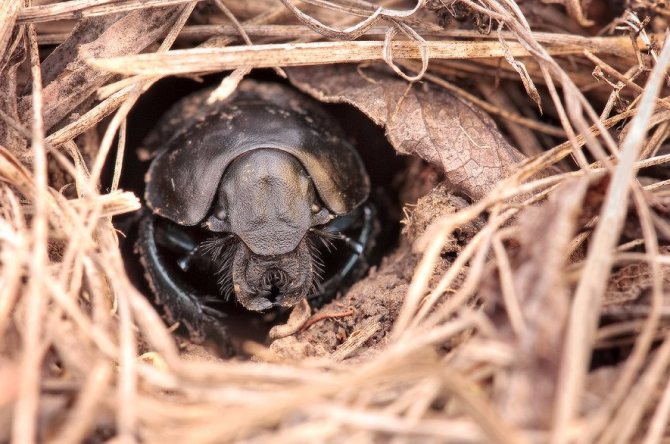

You can find out about the presence of kravchik on the site by looking at burrows and stumps of stalks around them. The holes of the minks are quite wide and visible to the eye, but their depth and ramification presents a certain difficulty in destroying the pest.
Did you know? Beetles have been accompanying humanity for a long time, unfortunately, not always out of good intentions. In addition to spoiling crops, there are gourmets who chew with pleasure museum samples of tapestries and antique furniture, stuffed animals, woolen carpets and furs, ancient tools made of valuable wood species.
How to deal with the snow beetle (kravchik, barbel)
Start off fighting snow beetle it is necessary immediately, as soon as it is found on the site.
The first sign by which one can determine its presence is the stems and leaves of cultivated plants cut like a razor.
Moreover, the pest “shears” not only vegetable crops. He also does not refuse decorative plantings: lilies, peonies and other garden flowers. It also damages young shoots of grapes, currants and other fruit bushes and trees.
How to recognize a snow beetle
The insect reaches a length of about 2.4 cm, has a rounded, slightly oblong body, which consists of two segments: a back protected by a dense black shell and a large head with developed upper jaws. The beetle cannot fly, since the elytra are spliced in the center, but it has very strong long legs, on which the insect quickly moves along the ground.
It feeds on leaves, buds and young shoots. If you do not take measures to combat the kravchiks, in 3-4 years they will fill the entire site, and then it will be almost impossible to survive them from the garden.
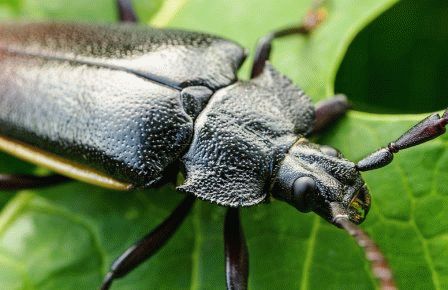

Why are kravchiks dangerous?
In burrows, greens extracted from the surface of the earth are impregnated with a special compound released from the salivary glands of the strigons and stored in dedicated chambers. In the green mass, the fermentation process takes place, and it turns into silage, which subsequently feeds on the offspring of the strigons.
Methods of dealing with snow beetle
The entrance to the kravchik's mink is immediately noticeable, it is a regular-shaped hole with a diameter of about 1.5 cm. The fight against the snow beetle should be concentrated precisely near the minks.
There are several popular methods for destroying the strigons. First, it is sunflower oil... You can buy the cheapest low quality oil, dilute it with water, mix well, and pour it into the holes. Oil prevents air from entering the burrow, and insects come out in a semi-dead state, where they are easy to catch and destroy.
You can also strigunov dig... Having found a mink, a shovel is stuck at a distance of 10 cm from it, and a lump of earth is turned inside out. As a rule, almost always a beetle is found on the shovel, which is simply choking on the shoes.
Since beetles do not fly, they get to the site by moving along the soil. Having made a groove around the garden with a depth of 30 cm, uninvited "guests" who have got into it can be collected by hand.
In the complex fight against insect pests, loosening of the soil is included, destroying the entrances to burrows.
Insecticides are ineffective in the fight against kravchiks, since the pests are deep underground (sometimes minks reach 70 cm in length). But chemicals are used to spray the edges of the site to keep out migratory insects. Also, the grass is processed with store preparations and laid out in grooves dug around the perimeter of the garden.
Snow beetles are tenacious, and it is quite difficult to remove them from the garden. It is possible to achieve the effect if you start fighting them in time and apply methods for their destruction in a complex.
Life cycle and nutrition
Like all coleoptera, longhorn beetles are dioecious and oviparous insects with complete transformation - first a larva appears from the egg, which does not look like an adult, which turns into an immobilized pupa, and then into an adult (an adult). The life cycle is 1–2 years and consists of 4 stages:
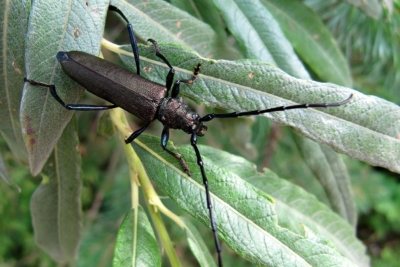

- Egg. The female lays up to 400 eggs in the most suitable place, giving preference to wet grass and soft bark. She gnaws holes and lays eggs, sometimes one in each hole.
- Larva. It looks like a white worm with processes along the edges of the body instead of legs and a head with a powerful jaw. The most important thing for larval development is warmth and humidity.
- Doll. With the end of the cold weather, the larva moves to the outer layers of the wood and pupates.
- Imago. At the end of spring, the pupa climbs to the surface and becomes an adult beetle.
The ability of larvae to survive is enormous - under unfavorable conditions, they can be preserved for tens of years.
Eating habits are determined by the habitat. Adults can feed on tree bark. Many beetles have evolved into new subspecies due to the feeding preferences for their larvae:
- Oak barbel prefers to make masonry in hard wood - oak.
- The black barbel beetle (pine or ship) prefers conifers.
- The purple barbel beetle loves to feast on delicate needles.
A bit of biology
Longhorn beetles are rather small (from one to several tens of millimeters), flat body and whiskers, which are the main organ of smell. The color of woodcutters is usually brown or dirty gray, less often it is a black barbel beetle. The photo allows you to take a closer look at the insect.
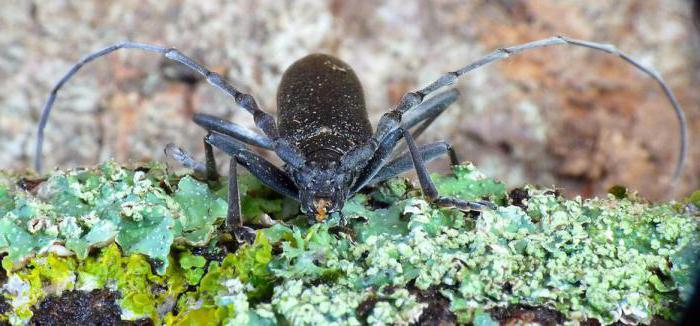

The larvae of the pest are characterized by especially powerful jaws, due to which they are "in the teeth" both hard woods and soft metal with cable-type coating. The latter, nevertheless, the beetles do not eat so willingly, preferring wooden structures and stacked boards.
Read also: Incubator thermostat: DIY instructions
The barbel female lays her eggs (from 200 to 400 pieces) in the grooves or cracks in the tree, and after 7-14 days the larvae are born, which instantly activate the process of tree destruction.
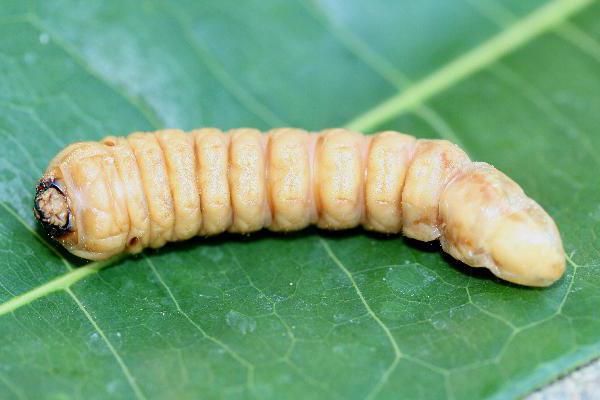

It is worth emphasizing that it is almost impossible to immediately notice a tree disease, since the larvae lead a hidden lifestyle. So you can understand that your wooden house has succumbed to the harmful effects of longhorn beetles when the real results of their work will be visible (destroyed and loosening wood).
Features
The woodcutter beetle has a number of characteristic features that distinguish this type of pest from many others. These include:
- Long mustache. The barbel beetle has an outstanding whisker, which is 2-5 times longer than the insect itself.
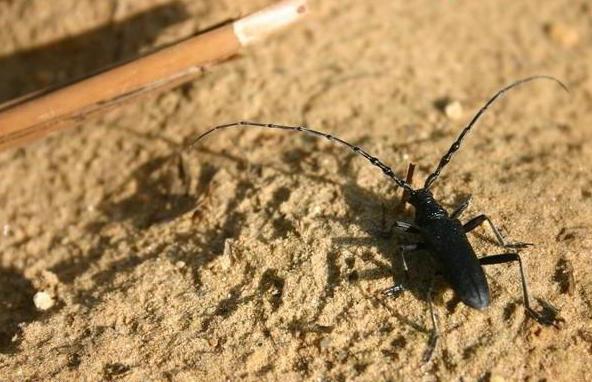

- Slim and elongated body. The body length varies from 3 to 60 mm.
- Wings. Some species of woodcutter beetles can fly.
Natural enemies of the insect
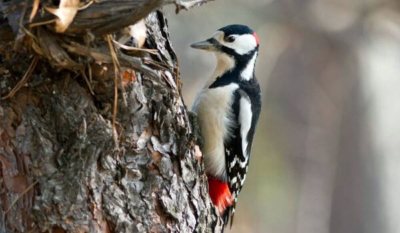

The natural enemies of woodcutters include:
- woodpeckers and other birds;
- predatory insects;
- parasitic microorganisms.
Lumberjack larvae often fall prey to wasp wasps, parasitic microorganisms and other types of beetles.
Where can you meet?
The barbel beetle can live and reproduce not only in various tree species, but also in shrubs and herbaceous plants. Barbel females lay their eggs in a crack in the tree bark, in depressions on branches, trunks or stems. Moreover, the pests do these cracks and grooves themselves.
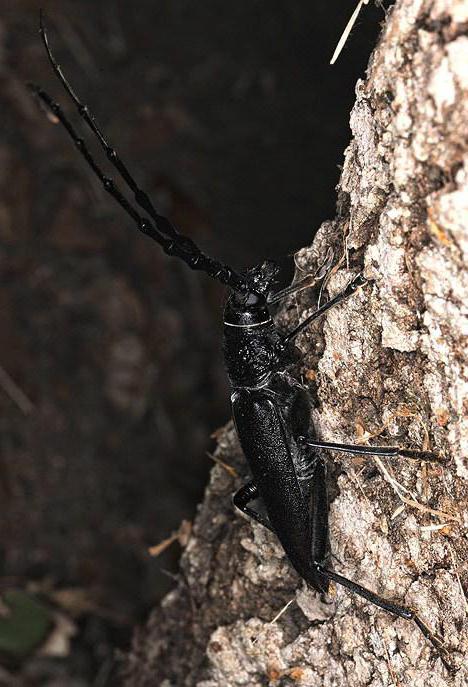

Lumberjacks can "visit" you at the dacha, and the timber industry can also "boast" of such guests. In country houses, the objects of attack by the pest are furniture, boards and other wood products.
What if you find a barbel at home?
If a mustachioed pest is found in the house, then an emergency response is needed. Why? It's just that if this insect starts up in wood, namely, it is the main material of your home, then it will not calm down until it eats it or, as they say, if it doesn’t eat it, it will spoil it, causing significant damage to the building as a whole.
The longhorn beetle does not pose a danger to humans, but it can harm him by destroying his home. In order for the insect to be at ease with your home, the tree should be processed even during the construction phase. There are several ways to protect wood. Fumigation through the use of phosphine gas is considered to be the most effective and optimal. This method of wood processing is held in high esteem by both owners of wooden buildings and carpenters, who process each unit individually.
The barbel beetle visited your house and settled in it - a problem, the solution to which consists in the following actions:
- Assess the degree of damage to the material. To do this, you need to take a screwdriver and try to pierce the tree. If the tool enters easily, then it is impossible to do without the elimination of a separate section of the surface of the house or the structure of timber (rafters, frames, beams). This is direct evidence that your house, or some of its elements, is being eaten by a barbel beetle. See a photo of a damaged wooden beam below.
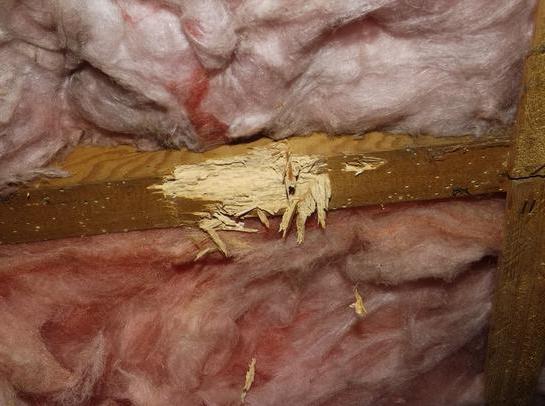

Solid wood can be left, but undergo a special treatment.
- Prepare the structure for the machining process. Clean the wood surface with a hard brush. In this case, the person involved in this process must have special uniforms: a respirator, glasses.
- Remove the dust layer with a vacuum cleaner.
- Cover the wooden surface with insecticide. Irrigate even surfaces, but intensively moisten the holes and cracks with the product.
- Close all door and window openings in the room for several hours (usually 34 hours).
- If the wooden surface is open, it must be systematically treated with hot linseed oil. It is worth replacing that this option is far from the best, because when processing with such a material, the original texture of the material is changed.
- To resort to the use of special means that penetrate deeply into the tree and are distinguished by a long period of preservation of their properties: "Antizhuk", "Empire-20", "Antishashelin".
- Treat the tree with antiseptics once every 12 months. It is best to do this in the month of June.
- Treat the affected areas of wood with carbon disulfide.
- Expose the affected tree to high temperatures (within 74 degrees). This can be done with a specially designed device, which will not be difficult to find and purchase.
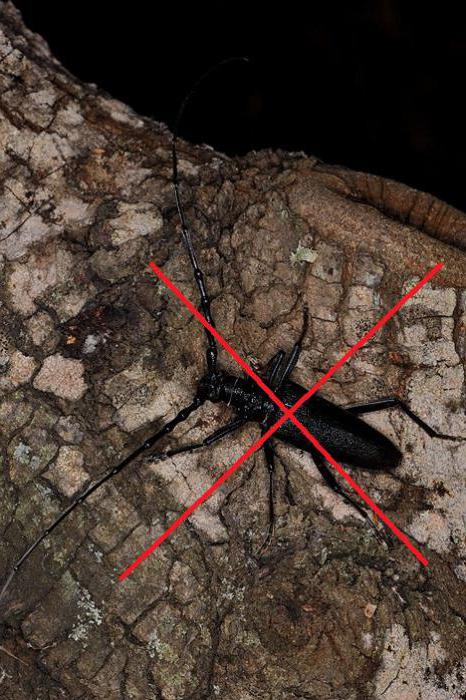

Prevention measures
To prevent longhorn beetles from causing damage to your structure, you must:
- conduct a thorough examination of the wood for the presence of holes made by insects;
- if damage is found, use special protective equipment;
- keep the room dry, since excessive humidity is one of the favorable living conditions for insects;
- for preventive purposes, wooden surfaces must be periodically treated with special insecticidal agents;
- use material that is not infested with insects for construction, it is easy to see this when the wood is cleaned of bark;
- in case of severe infection of wooden structures, they should be replaced with new elements.
By periodically carrying out these simple activities, you can protect the house from pests.
Barbel beetle: how to get rid of?
Special means of various actions will help to overcome the barbel in your own home. What specific means to choose in this or that case is up to you!
Read also: Why is ginseng useful and harmful?
Conventionally, such funds can be divided into three groups:
- Contact. They show their effect directly upon contact with the barbel beetle. Such funds are not popular because their use can harm human health.
- Intestinal. These agents include sodium fluoride, zinc chloride and other components that show their harmful effects on the insect through the intestines.
- Fumigants. These are gaseous and vaporous substances: sulfur dioxide, dichloroethane, etc.
Remember that a solid wood, on the surface of which there are no cracks or other defects, is not of interest to pests. The barbel beetle will live and reproduce only in cracks. Therefore, you will not go wrong if you pour the special agent into the paths of the wood blade with a syringe, and then cover these holes with putty on wood or ordinary plasticine.
Remember that it is very difficult to defeat barbel! It is much easier to resort to preventive methods, for example, using exclusively fungicide-impregnated wood for construction purposes.
It is interesting!
The barbel family includes not only annoying wood pests, but also representatives of the Red Book of Russia. One of them is the relict barbel beetle (lumberjack). Its habitat is the broadleaf forest of the Far East. A distinctive feature is the body length, reaching 11 centimeters. To meet such a beetle is a great success.Another titan lumberjack, who has received the status of "the largest beetle of the planet", and a long-legged harlequin, in which the length of the front-type limbs is greater than the length of the body, need protection.
The appearance and dimensions of the barbel
Representatives of the barbel family are quite diverse and it will sometimes be difficult for a non-specialist to guess that these two beetles are related. Longhorns can vary in color, size and shape, with or without spines and bumps. Thanks to this, the barbel is a fertile ground for study and collecting by entomologists. The barbel is mostly medium and small in size, but there are also large individuals. These include:
- woodcutter titanium (16-21 cm);
- lumberjack-big-toothed (16 cm);
- barbel Xixuthrus heros (15 cm);
- Ussuri relict barbel (11 cm) - the largest beetle in Russia;
- carpenter barbel (6 cm) - the largest of the European barbel.
The color of the barbel is also striking in its variety, and both the chitin itself and the hairs located on the body can be colored - sometimes these colors do not match. Coloring even within one species freely changes from pale yellow and even white to black, metallic shades are often found. Not uncommon for barbel and a pattern on the body, made up of the so-called bands, spots and stripes.
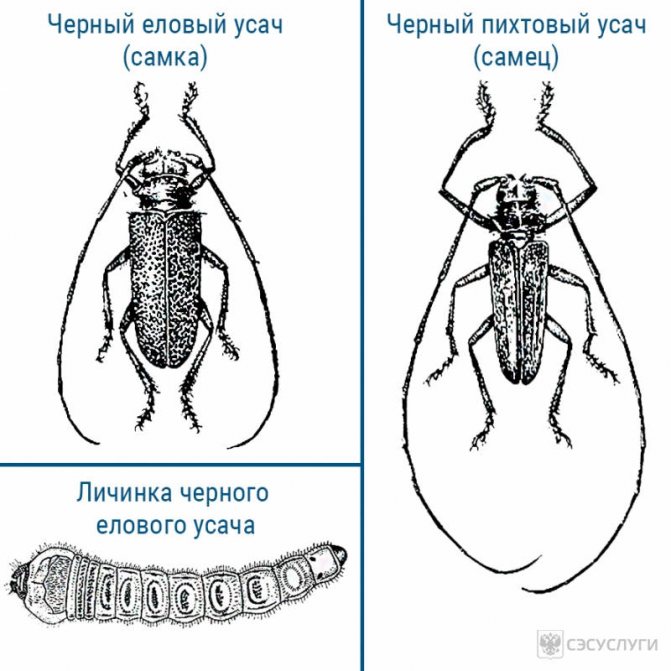

You can distinguish a male barbel by color, pointed abdomen, elongated antennae and upper jaws, but the size of the beetle cannot tell the sex.
Virgin land, strigun, kravchik
Large beetles reaching 3.5 cm in length, prefer to live on untouched lands, but with the development of agriculture and human occupation, more and more land areas settle in the vicinity of cultivated areas, which makes it easier for them to find food.
The head is flattened, large, with a straight line connecting the forehead and clypeus, with a pair of eyes located along the edges of the cheek protrusions.
Before the eyes there is a pair of rigid antennae, at the ends of which there are brush-like thickenings. The males have canine-like rigid processes on the jaw, with which the males win the right to mate. The mandibles, covered with short hairs, are hidden between the canine teeth. In females, the jaw processes are smoothly rounded, they do not have canines.
The sheared has three pairs of tenacious and strong limbs, which are covered with stiff hairs, and claws are present at the ends of the legs.
The wings are not developed, this species does not fly, it has rigid and short, accrete elytra.
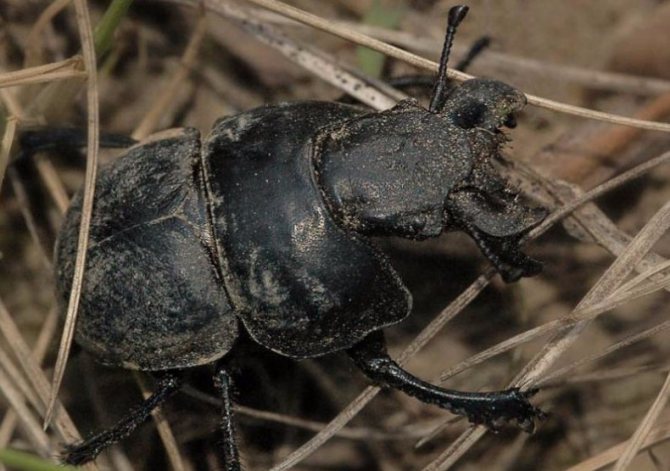

Barbel structure - from mustache to legs
The body of the barbel beetle consists of:
- Heads. It can be either medium in size or large, with highly developed front jaws. In barbel, two types of head are distinguished: with an inclination forward or down. The eyes are faceted, located on the sides of the head. In some lumberjacks, they are so strongly divided into two parts that it seems that the barbel has two pairs of eyes. The antennae are located between the eyes, on the forehead.
- Usikov. They are most often simple, sometimes scaly or serrate. They consist of segments from 15 to 31. As a rule, antennae are 4-6 times longer than the rest of the body.
- Breasts. Consists of three fragments - the first of them is the most developed. Accordingly, the back is also divided into three parts. Visually, only the pronotum can be seen in the barbel - the rest of the parts are hidden by the wings.
- Elytra and wings. Almost all barbel species can boast of wings and well-developed elytra. But there are also species that have lost the ability to fly. The flight of woodcutters is slow and difficult, only a few species are capable of easy and fast flights.
- Limbs. Subdivided into five parts: coxa, trochanter, femur, tibia and tarsal segments. The first pair of legs is the shortest, and the last is the longest, but in some species the front pair can be several times longer than the body of the beetle.
- Abdomen. The abdomen is soft and consists of five segments. Females are usually thicker than males.
On a large individual barbel, found in houses, you can easily consider all of the above elements.
Harm and danger
The ringworm beetle is more than dangerous for cultural plantings, because it multiplies quickly and quantitatively. One female lays eight to ten eggs in a clutch, but this is only one mink. Several of these minks per square meter pose a real threat to vegetation covering an area ten times larger.
To provide their offspring with food, beetles cut off with their powerful jaws literally all the greens in their path: stems, foliage, buds with inflorescences, even a green, not lignified vine.

